Protecting
Welcome to Old Garden Tools collection of Protecting Tools. We have laid our images out in museum style so that you may concentrate just on the images without any other distractions. Just hover over the image or click on it to see a larger version with some additional information.
Please contact us if you require further information.
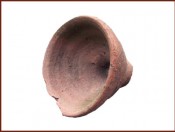 Artichoke Protector A
Artichoke Protector A
French. C1900. Delicate terracotta cloches placed over the flower to protect from rain.
Please contact us if you require further information.
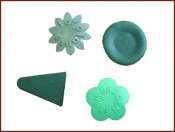 Cane Protectors
Cane Protectors
English. Late 20C. A variety of 4 rubber and plastic eye protectors to protect gardener visually and physically when bending over cane. 1 to 2 inches.
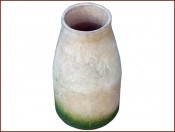 Celery Forcer B
Celery Forcer B
English. 20C. Terracotta.
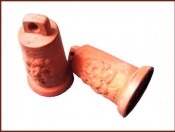 Cloche B
Cloche B
English. C1900. A pair of tiny terracotta cloches bearing oak tree motif. Rare.
 Cloche C
Cloche C
French C1900. Lettuce blanching cloche. Terracotta with 3 aerating perforations and lifting knop.
 Cloche D
Cloche D
French. Dia 11.75 inches (30cms).
 Cloche E
Cloche E
French. 20C. Crop protecting Cloche made of woven steel wire. This example from Normandy. France. Available in different sizes and featured in the ‘Manufrance’ catalogues. Dia 23 inches (58cms) x H 15.5 inches (39cms).
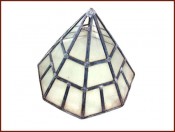 Cloche Glass A
Cloche Glass A
English. Late 19C and early 20C. Pair. Ref: William Cooper catalogue 1895. And Wm Wood & Son 1909 catalogue – Cap glass 20 & 21 inches. Zinc and 16 oz glass. Finger hole in top panel to lift. W 20 inches (51cms) x H 15.5 inches (39.4cms).
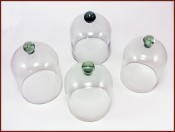 Cloche Glass C
Cloche Glass C
Set of 4. Minature. Ex Nursery West country UK. Typical English Bell Glass shape Ref TGEW p50 Glass cloches first used in France 1600 then 1629 in England. 1677 Square cloches. 1600’s Cold Frames used also from old windows. Loudons Art of Gardening 1950 shows Bell Glasses or ‘Crystal Bells’ from 3 inches to 8 inches in diameter. Corry & Co Trade price list of 1931 sold these as ‘Propagating Glasses’ in 6, 7, 8, 9, 10, 11, and 12 inches.
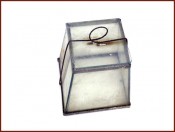 Cloche Glass G
Cloche Glass G
English C1945. Designed for Chase during the war. Sold from circa 1945. Square Handlight by Chase. Book ‘Cloche Gardening by J Chase first published 1948. Held here in the collection. 5 inches square. 4.5 inches high. Subimage compares with 6 inch size.
Please contact us if you require further information.
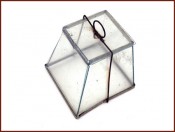 Cloche Glass H
Cloche Glass H
English C1945. Designed for Chase during the war. Sold from circa 1945. Square Handlight by Chase. UK. 6 inches square. 6.5 inches high. Subimage compares with 5 inch size.
Please contact us if you require further information.
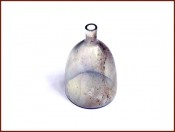 Cloche Glass J
Cloche Glass J
French. Late 19C. Open knop. No stopper. H 6 inches (15cms) x Dia 4 inches (10cms).
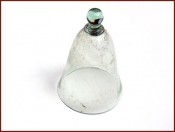 Cloche Glass K
Cloche Glass K
French. 19C. Miniature glass Cloche. 7.75 inches (19.6cms) x Dia 5 inches (12.8cms).
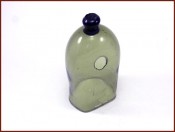 Cloche Glass O
Cloche Glass O
English 1820 – 30. Grape Cloche. One flat side with cut hole. There is known to be one other in existence in plain glass. The date can be accurately determined by glass experts.
 Cloche Glass P
Cloche Glass P
English. C1900. Greenish glass. Regular shape with knop. 10 inches high. 12 inches diameter.
 Cloche Glass R
Cloche Glass R
Blue turquoise with hollow knop. 14 inches high. 13 inches diameter.
 Cloche Glass Y
Cloche Glass Y
French. Mid 1800’s. Set of 5 Melon Cloches. With years of collected material staining the hand blown glass. Very light in weight. Knops removed during manufacture to avoid concentrating solar rays onto the fruit. This also helped stacking.
 Cloche Glass Z
Cloche Glass Z
C1900. Small Cloche with manufactured 1/2 sheared knop. H 5.2 inches (13.2cms) x Dia 4.2 inches (10.6cms).
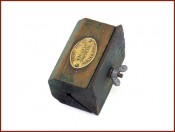 Cloche Clamp
Cloche Clamp
‘The Dixit’ Cloche Clamp. Stained wood and metal. Takes 2 panes of glass to form cloche. English 1950. L 3 inches (7.6cms).
 Cloche Glass AA
Cloche Glass AA
19C. Miniature hand blown glass Cloche. H 4.3 inches (11.2cms) x Dia 3.25 inches (8.4cms).
 Cloche Glass AB
Cloche Glass AB
English. C 1930’s. Pair of Handlights. ‘Nettlefold’s Premier Handlight’. 1 with metal embossed label missing. Similar to The ‘Suntrap’. Little greenhouse as illustrated in Richard Mellhuish catalogue showing the handlight placed over a seedbox and with small round adjustable ventilators at each end. Ref also as ‘Sun Trap’ in George Harding catalogue 1935. 18 inches (46cms) x 12 inches (30.5cms) x H 12.5 inches (32cms).
 Cloche Glass AC
Cloche Glass AC
English. Late 19C. Octagonal small Glass Cloche. Removable top. Reglazed. H 18 inches (46cms).
 Cloche Glass H
Cloche Glass H
Heavy frosted finish, splayed with solid cylindrical knop. 12 inches high. 17 inches diameter.
 Cloche Glass I
Cloche Glass I
French. C1900. Greenish glass. Fenestrated with original stopper. 9 inches high. 9 inches diameter.
 Cloche Glass L
Cloche Glass L
French. C1900. Small size with oblong knop. 7 inches high. 5 inches diameter.
 Cloche Glass Q
Cloche Glass Q
English. C1900. Regular shape with round knop. 11 inches high. 14 inches diameter.
 Cloche Glass S
Cloche Glass S
British. 1980. Plastic. 11 inches high. 13 inches diameter.
 Cloche Glass T
Cloche Glass T
Mid to late 19C. Tall with stipple decorated knop. White glass. 15 inches high. 12 inches diameter.
 Cloche Glass U
Cloche Glass U
Medium size. C1900. Solid ball knop. White glass. 9 inches high. 7.5 inches diameter.
 Cloche Glass V
Cloche Glass V
Hexagonal steel and glass. 20C. 16 inches high. 18 inches wide at max.
 Cloche Glass W
Cloche Glass W
French. 19C. Hand blown with knop. Pair. Whitewashed inside top surface. H 11.25 inches (28.6cms) x Dia 20.25 inches (51.3cms).
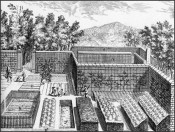 Cloche History
Cloche History
This image shows a 17th century kitchen garden. There are cloches in use in great numbers.
 Cloche Pegs A
Cloche Pegs A
French C1900. 2 Cloche Pegs or Supports to raise one side or at 3 points of glass cloche to allow air movement and cool interior of cloche. 12.5 inches (12.5cms) and 9 inches (23cms).
Please contact us if you require further information.
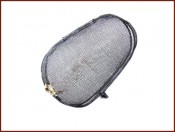 Grape Protector A
Grape Protector A
French. Early 20C Reference ‘Allez Freres of Paris’ Catalogue 1900 – 1910.
Please contact us if you require further information.
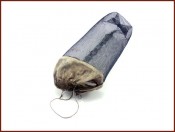 Grape Protector B
Grape Protector B
French. Early 20C. (A similar protector was made in England from scrim for protecting grapes, apples and pears etc. Ref: Wm Wood & Son 1090 catalogue.)
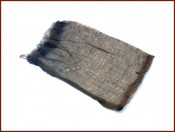 Grape Protector C
Grape Protector C
French. Early 20C. Thomery France. Used to protect bunches of the Chasselas desert grape. Brown woven fabric with string draw. 9 inches (23cms) x 6 inches 15cms).
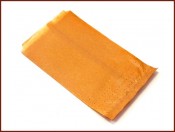 Grape Protector D
Grape Protector D
French. Early 20C. Perforated paper bags from Thomery France. These were used to protect the Chasselas dessert grapes from pests. 13.25 inches (33.5cms) x 7.8 inches (20cms).
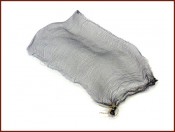 Grape Protector E
Grape Protector E
French. Early 20C. Thomery Village to protect bunches of the Chasselas desert grape. Woven fine wire gauze with string draw. 11 inches (28cms) x 7 inches (18cms).
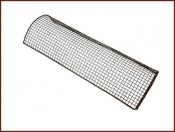 Pea Guard
Pea Guard
English. Mid 20C. Welded steel mesh on hooped frame. L 24.25 inches (61.5 cms) x W 8.5 inches (22.5cms).
 Wardian Case A
Wardian Case A
English. Early 20C. The case framed in leaded lights and glazed with green glass at the lower (subsoil) level. 1 lateral light slides up in its lead channel for access. There are 4 brass bun feet and 2 brass finials. The case came with contemporary instruction and explanation sheets in the type face of the era. The case contains a succulent bearing a plastic label inscribed ‘Hanworthia Attenuata Striata’. The plant is of maximum size and appears contempory with the period of the case. L 17 inches (43.2cms) x H 17 inches (43.2cms) x W 8.25inches (21cms).
The Wardian Case was invented following a scientific experiment with philanthropic aims. It was soon used commercially as a means of transporting living plants from the far corners of the globe to satisfy the demands of wealthy landowners and enhance the collections of Botanical societies.
In 1829 Dr Nathaniel Bagshaw Ward’s medical practice was near St Katherine’s dock. A keen naturalist, he grew plants in his back yard but the air was heavily polluted by emissions from factory chimneys and the sulphuric gases and acid rain made it hard for many plants to establish. Finding a fern and a grass seedling growing in an ait tight jar influenced Dr Ward to have a glass case made to grow ferns in.
The Wardian Case carried medicinal, economic and ornamental plants all over the world. One of Dr Ward’s correspondents was William Jackson Hooker, later director of the Royal Botanic Gardens, Kew. Hooker’s son Joseph Dalton Hooker was one of the first plant explorers to use the new Wardian cases, when he shipped live plants back to England from New Zealand in 1841, during the pioneering voyage of HMS Erebus that circumnavigated Antarctica.
Wardian cases soon became features of stylish drawing rooms in Western Europe and the United States. In the polluted air of Victorian cities, the fern craze and the craze for growing orchids that followed, owed much of their impetus to the new Wardian cases.
More importantly, the Wardian case unleashed a revolution in the mobility of commercially important plants. Robert Fortune shipped to British India 20,000 tea plants smuggled out of Shanghai, China, to begin the tea plantations of Assam. After germination of imported seeds in the heated glasshouses of Kew, seedlings of the rubber tree of Brazil were shipped successfully in Wardian cases to Ceylon (Sri Lanka) and the new British territories in Malaya to start the rubber plantations. Wardian cases have thus been credited for helping break geographic monopolies in the production of important agricultural goods.
Dr. Ward was always active in the Society of Apothecaries of London, of which he became Master in 1854. Until very recently, the Society managed the Chelsea Physic Garden, London, the oldest botanical garden in the UK. Ward was a founding member of both the Botanical Society of Edinburgh and the Royal Microscopical Society, a Fellow of the Linnean Society and a Fellow of the Royal Society. L 17 inches (43.2cms) x H 16 inches (40.6cms) x W 8 inches (20cms).




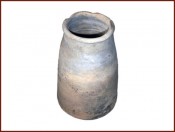 Celery Forcer A
Celery Forcer A
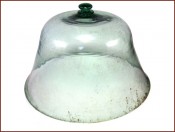 Cloche Glass D
Cloche Glass D




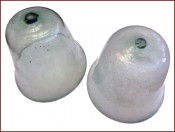 Cloche Glass X
Cloche Glass X




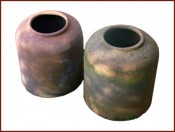 Rhubarb Forcer B
Rhubarb Forcer B